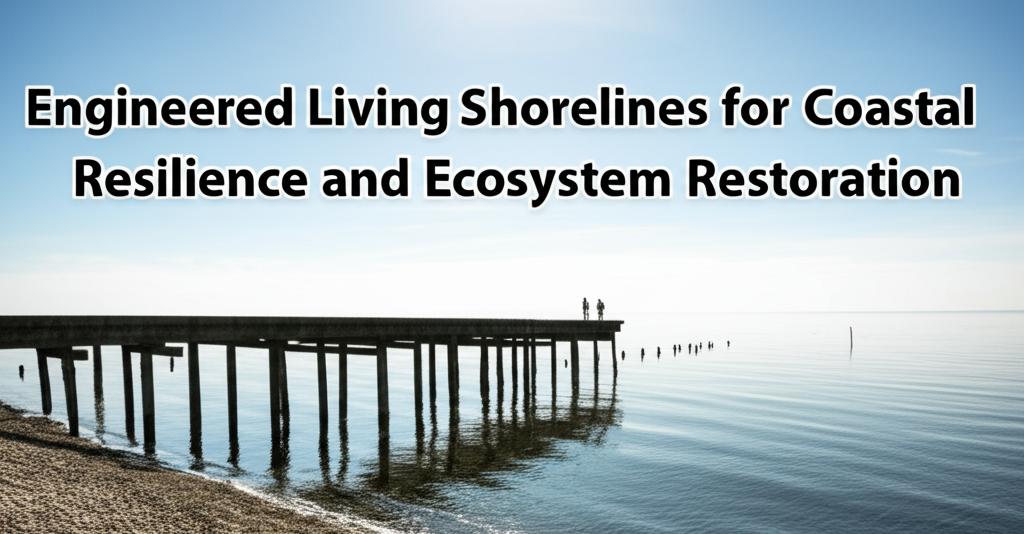Engineered living shorelines represent a dynamic and expanding approach to coastal management, offering a nature-based solution to erosion and a pathway to restoring vital ecosystems. These shorelines are meticulously designed and constructed using natural materials such as plants, sand, and rock, often combined with structural elements, to stabilize coasts, enhance habitat, and increase overall resilience.
Core Principles and BenefitsLiving shorelines work by mimicking natural coastal processes. The core idea is to integrate vegetation and other natural elements, sometimes with harder structures like oyster reefs, rock sills, or anchored wood, to create a stable and resilient coastal edge. This approach contrasts with traditional "gray" infrastructure like seawalls and bulkheads, which can damage ecosystems and impede natural coastal functions.
The benefits of engineered living shorelines are multifaceted:
- Erosion Control: They protect shorelines from wave energy and storm surge, reducing land loss. They are often designed to be more resilient to storms than hardened structures.
- Habitat Creation and Restoration: Living shorelines provide critical habitat for a diverse range of species, including fish, crabs, birds, and oysters. They support the restoration of salt marshes, mangroves, seagrass beds, and other vital coastal ecosystems.
- Water Quality Improvement: The vegetation and oyster reefs incorporated into living shorelines help filter pollutants and excess nutrients from the water, improving overall water quality. Oysters, for example, can filter large volumes of water daily.
- Increased Resilience and Adaptability: These are living systems that can adapt to changing environmental conditions, including sea-level rise, and can often self-repair after storm events.
- Economic Advantages: While initial costs can vary, living shorelines can be more cost-effective in the long run compared to maintaining or replacing hard structures. Studies have shown significant economic benefits from the ecosystem services they provide, such as enhanced recreational fishing.
- Carbon Sequestration: Coastal habitats like marshes and mangroves, which are often part of living shoreline projects, are effective at capturing and storing atmospheric carbon ("blue carbon").
The field of engineered living shorelines is continuously evolving, with ongoing research and innovative designs:
- Hybrid Designs: Combining "green" (vegetation) and "gray" (structural) elements is a key trend. This allows for effective shoreline stabilization even in higher-energy environments where vegetation alone might not suffice. Examples include using rock sills or oyster castles to protect newly planted marsh grasses.
- Material Innovation: New materials and techniques are being explored. For instance, recent projects have piloted the use of basalt rock fiber for oyster shell bags, aiming for greater durability and habitat integration compared to traditional biodegradable options like coconut fiber.
- Bioengineered Systems: Patented systems using materials like burlap sock-like fabric and heavy-duty knitted mesh, filled with local sediment or muck, offer immediate stabilization and a platform for vegetation growth.
- Regional Guidance and Collaboration: Efforts are underway to standardize design and construction practices, share best practices, and streamline permitting processes to promote wider adoption of living shorelines. Initiatives like the "Regionally Advancing Living Shorelines Project" in San Francisco Bay aim to enhance information sharing and develop engineering concept designs.
- Focus on Ecosystem Services: There's a growing emphasis on quantifying and incorporating the diverse ecosystem services provided by living shorelines into cost-benefit analyses and decision-making processes. This includes their role in supporting fisheries, improving water quality, and sequestering carbon.
- Integration with Broader Resilience Strategies: Living shorelines are increasingly seen as a key component of larger coastal resilience plans, working in concert with other nature-based solutions and, where necessary, traditional infrastructure.
Numerous case studies demonstrate the effectiveness of engineered living shorelines:
- In South Carolina, projects using oyster shell bags, manufactured wire reefs, and coir logs have shown significant oyster colonization, sediment accumulation, and marsh growth.
- The "Living Breakwaters" project in New York integrates risk reduction with ecological enhancement and social resilience through nearshore breakwaters.
- Along the Georgia coast, oyster shells are widely used to create reefs that deflect wave energy, filter water, and attract other species, enhancing shoreline resilience demonstrated by their survival through multiple hurricanes.
- Projects in the Chesapeake Bay area are testing innovative materials like basalt shell bags to improve the longevity and habitat value of oyster reefs.
- In Florida, demonstration sites showcase various techniques from fully green (oyster reef sloping to high marsh) to rehabilitated seawalls with oyster reefs and mangroves.
Despite the clear benefits, some challenges to wider implementation remain:
- Permitting Processes: Permitting for living shorelines can sometimes be more complex or lengthy compared to traditional gray infrastructure, although efforts are being_made to streamline these processes.
- Site-Specific Design: The success of a living shoreline depends heavily on site-specific conditions like wave energy, sediment type, and existing ecology, requiring careful assessment and design.
- Long-term Monitoring: Continued monitoring is crucial to assess the performance of living shorelines, adapt management strategies, and further refine design guidelines.
- Knowledge Transfer and Education: Ongoing efforts are needed to educate property owners, coastal managers, and the public about the benefits and feasibility of living shorelines.
The future of engineered living shorelines looks promising. As coastal communities increasingly face the impacts of climate change, sea-level rise, and erosion, the demand for resilient and ecologically sound solutions will only grow. Continued research, innovation, supportive policies, and collaborative efforts will be key to unlocking the full potential of living shorelines to protect our coasts and restore vital ecosystems for generations to come.

